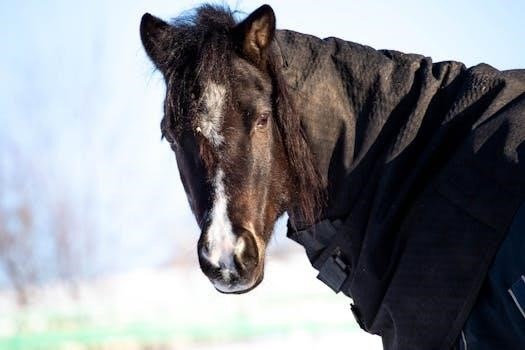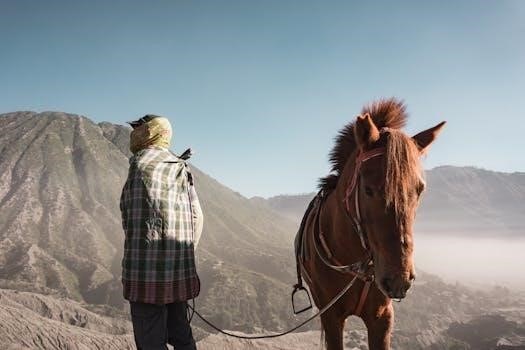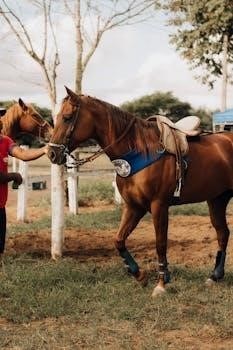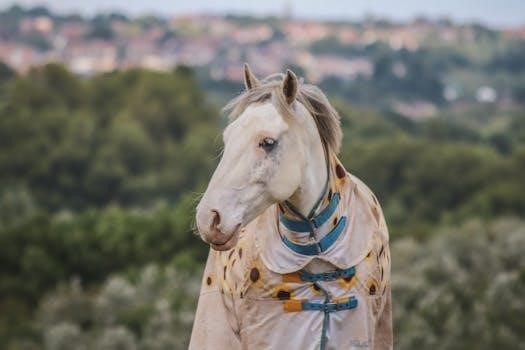Finding the perfect horse blanket is essential for your horse’s comfort and well-being. Proper sizing ensures the blanket stays in place, providing adequate warmth and protection. This guide will help you navigate the process of selecting the ideal fit;
Importance of Proper Fit
A well-fitting horse blanket is crucial for several reasons. Firstly, it ensures your horse’s comfort, preventing chafing and pressure points that can lead to sores. Secondly, a blanket that is too tight can restrict movement and cause discomfort, while one that is too loose can slip, potentially causing injury. Furthermore, proper fit is essential for the blanket to provide the intended level of warmth and protection from the elements. An ill-fitting blanket may not cover the horse effectively, leaving vulnerable areas exposed to cold or rain. A correctly sized blanket will also stay in place, preventing the need for constant readjustment. Ultimately, the goal is to ensure your horse is comfortable, safe, and well-protected.

Measuring Your Horse for a Blanket
Accurate measurements are key to selecting the right blanket size. Use a soft tape measure and follow specific steps to ensure a comfortable and secure fit for your horse.
Step-by-Step Measurement Guide
Begin by ensuring your horse is standing squarely on a level surface. Use a soft, flexible measuring tape for accurate results. Start at the center of your horse’s chest and extend the tape along the side, over the widest part of the shoulder, and continue to the center of the tail. Keep the tape measure taut but not too tight. It’s helpful to have someone assist you to keep the tape straight. This measurement is the length of the horse’s body and is the primary measurement for blanket sizing. After taking this initial measurement, deduct approximately 4 inches (10 cm), this will give your horse’s true blanket size. Round up to the nearest even number if necessary; Always double-check your measurements to ensure accuracy before consulting size charts.
Common Measurement Mistakes
One common mistake is measuring while the horse is not standing squarely, leading to an inaccurate length. Another error is holding the measuring tape too loosely or too tightly, which can distort the true size. Measuring only the top line instead of including the widest part of the shoulder and hindquarters also results in a poor fit. Forgetting to deduct the 4 inches (10 cm) for the true measurement can lead to selecting a blanket that is too large. Also, using a rigid measuring tape may not conform to the horse’s curves, affecting accuracy. Not rounding up to the nearest even number, as most sizes are in increments of two inches, is another mistake. It is crucial to double-check all measurements.

Understanding Size Charts
Size charts are crucial for selecting the correct blanket. These charts typically provide measurements in inches, and sometimes centimeters, correlating to different horse sizes. Utilizing these charts effectively is key.
How to Use Size Charts Effectively
To use a horse blanket size chart effectively, begin by accurately measuring your horse. Measure from the center of their chest, across the widest part of the shoulder, to the center of the tail. Keep the tape measure taut and level. This measurement, typically in inches, should then be compared to the manufacturer’s size chart. Most charts provide sizes in increments of two inches, usually rounding up to the nearest even number. Remember that these charts are a guide. Some brands have slightly different sizing conventions, so always refer to the specific chart provided by the manufacturer. If your horse falls between sizes, it is generally recommended to go up to the next size for a more comfortable fit. Consider the horse’s build as well; a wider or narrower horse may require adjustments from the chart’s recommendations.
Size Variations Across Brands
It’s crucial to understand that horse blanket sizes are not standardized across all brands. Significant variations exist, meaning a size 72 from one manufacturer might not fit the same as a size 72 from another. Some brands, like Weatherbeeta, are known for having roomier cuts, while others, such as Horseware, may fit differently. Furthermore, sizing can vary even within a single brand, depending on the specific style and cut of the blanket. Therefore, always consult the specific size chart provided by the brand you are considering, and never assume a size based on past purchases from different brands. Always double-check your horse’s measurements against each new brand’s chart to ensure a correct fit. Factors such as European vs. American cuts also contribute to these size differences.

Factors Affecting Blanket Size
Several factors beyond simple length measurements impact the ideal blanket size. A horse’s build, conformation, and the blanket’s style all play a role in ensuring a comfortable and proper fit.
Horse Build and Conformation
A horse’s unique build significantly influences blanket fit. A broad-chested horse, for instance, might require a blanket with a different cut compared to a narrow-chested one. The depth of the shoulder and the shape of the neck also affect how a blanket sits. Some brands offer specialized cuts like ‘XL’ to accommodate horses with deeper shoulders and wider builds, providing extra room in the neck and sides. Considering your horse’s individual conformation is crucial, as a blanket that fits one horse perfectly might be too tight or too loose on another, even if they are the same height. Therefore, it’s not just about length; it’s about how the blanket interacts with the horse’s specific body shape. Always check for these variations, and consider options like a disc front closure for a narrow-chested horse, or a wider cut for a deep shouldered horse.
Blanket Style and Cut
The style and cut of a horse blanket play a vital role in how it fits. Different designs cater to various needs and horse builds. For example, European and American cuts have different sizing standards, making it essential to understand which style you’re looking at. Some blankets are designed with a more generous fit, while others are more tailored. The presence of features like a disc front closure can impact how the blanket sits on the chest. Exercise sheets, also known as quarter sheets, are designed differently and typically only cover the hindquarters. Understanding the specific style and intended use of the blanket is crucial for choosing the right size. Variations between brands and even within a brand can influence fit, so always consult size charts and reviews.

Additional Considerations
When selecting a horse blanket, consider specialized sizing for liquid titanium sheets, which often fit like athletic shirts. Also, be mindful of variations in sizing for different brands and styles.
Liquid Titanium Sheet Sizing
Liquid titanium sheets, due to their unique design and fabric stretch, require different sizing considerations compared to standard blankets. These sheets are designed to fit more like athletic shirts on humans, so it is crucial to consider the horse’s muscle mass. Unlike traditional blankets, you may need to consider a smaller size than usual, paying close attention to how the sheet fits around the chest and shoulders. The goal is a snug yet comfortable fit that allows freedom of movement without being too loose. Take into account the stretch of the fabric, which may require adjustments from the common sizing rules used for regular horse blankets, ensuring the sheet is not too tight or restrictive.
Specialized Blanket Sizing
Specialized blankets, such as exercise sheets or those designed for horses with unique builds, often deviate from standard sizing. Exercise sheets, also known as quarter sheets, are intended to keep the horse’s hindquarters warm during work, so their fit focuses on the rear rather than the full body. For horses with deep shoulders, wide builds, or narrow chests, specific blanket cuts like “XL” or those with a disc front closure are necessary. These cuts accommodate unique conformations by adding depth in the neck and sides or by providing a more adjustable fit. It is very important to consider the intended use and your horse’s specific build when selecting specialized blankets to ensure a comfortable and effective fit.
